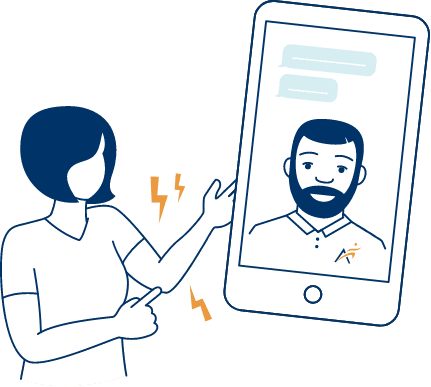(21,000+ reviews on Google across 150+ locations)

Have questions or would like to schedule over the phone? Call us at 844-719-5079
Find an Airrosti Clinic Near You (OH, TX, VA, WA)
We take the time needed for a thorough examination to find the underlying cause of your pain.
Airrosti Providers use hands-on manual therapy to treat your specific herniated disc injuries to reduce pain, increase mobility, and accelerate healing.
No surgery, injections, or prescription medication.
Patients have shorter recovery time with an average of 3.2 visits over 2 weeks.
Speed your recovery and keep your pain from returning.

Herniated discs are very common, but they’re not always the true cause of back pain. He also explores the various treatment options available for resolving this condition.
Still have questions or concerns about your herniated disc injury? Schedule a no-cost video chat with one of our Providers.
The spine is made up of a series of connected bones called “vertebrae.” The vertebral disc is a combination of strong connective tissues which hold one vertebra to the next and acts as a cushion between the vertebrae. These discs are made of a tough outer layer called the “annulus fibrosus” and a gel-like center called the “nucleus pulposus.” When the nucleus pulposus bulges or ruptures, it can press on the various nerve roots in your spine and can cause pain, numbness, or muscle weakness in the arms or legs.
A herniated disc may also cause back pain, but back pain alone (without leg pain) can have many causes other than a herniated disc. This condition is often known as a bulging disc or slipped disc, but its medical term is “herniated nucleus pulposus,” or more commonly, a “herniated disc.”
Disc injuries can be separated into three categories:
The disc begins to bulge from between the vertebrae. Although the disc remains attached, the bulging tissue can press on the spinal nerves.
The outer layer of the disc begins to tear, allowing the nucleus pulposus to leak outside the disc. With this type of herniation, the extruded tissue is still attached to the disc.
The nucleus pulposus bursts, completely separating from the disc. This is a rare type of disc injury, but it’s also the most severe.
The most common herniated disc cause is often natural disc degeneration over time. However, sometimes a traumatic or sudden movement, such as a fall or accident, can lead to a herniated disc. In addition, several lifestyle factors can increase your odds of suffering from a disc herniation, such as:
As you age, the disc may start to lose water content, making it less effective as a cushion for your vertebrae. Disc herniations are more commonly found in people over 40 years old.
Poor posture when sitting or standing can play a part in disc herniation, as it increases the pressure on your spinal column and discs. When being physically active, poor form while exercising, such as lifting, can cause a disc injury from using your back rather than your legs.
Partaking in activities that include sitting for long periods of time, such as gaming or watching TV, can increase your risk of a disc injury.
Those who are overweight or obese have a higher risk of suffering from disc injuries due to the increased pressure placed on bones and joints.
Wear and tear from physically demanding jobs can put excessive stress on the spine, especially if you’re repetitively lifting, pushing, or pulling.
Due to the complex nature and anatomy of the spine, you might have a herniated disc without even knowing. Herniated disc symptoms can vary dramatically based on the severity of injury, as well as location within the spine. In addition, you may feel pain moderately or intensely and experience multiple symptoms at once, or little to none.
The cervical spine is made up of seven vertebrae in the neck. The cervical vertebrae give the neck its mobility. If you’re suffering from a cervical disc herniation, you’ll likely experience a few of these symptoms:
• Upper back or neck pain that may feel dull or sharp
• Pain, numbness, or tingling in the shoulder and upper arm
• Arm and hand weakness
• Pain may increase with certain neck positions and movements
The thoracic spine consists of the 12 vertebrae of the mid back, below the cervical spine. It’s considered the most complex region of the spine since it is the only region where the vertebrae are also attached to the rib cage. Due to this specific location and structure, a thoracic disc herniation is likely to cause symptoms in the chest, abdomen, and mid back.
• Pain in the mid back, especially if the herniation is compressing a spinal nerve
• Chest pain
• Numbness or tingling that travels from the mid back to the chest or upper abdomen
• Weakness or numbness in the legs
The lumbar spine is made up of five large vertebrae in the lower back. Because these vertebrae are more mobile than the others and will endure the most force from activities like lifting and jumping, they are also the most vulnerable to spinal and disc injuries.
• Burning, tingling, or pain in the buttocks, legs, and feet
• Lower back pain that worsens when standing, sitting, or walking
• Pain, numbness, or tingling in the legs
• Possible incontinence
Surgery is not always necessary for a herniated disc. In many cases, conservative treatments such as rest, physical therapy, Airrosti care, medication, and spinal injections can effectively manage symptoms and promote healing. Surgery may be considered if conservative treatments fail to provide relief, or if there are signs of nerve compression causing severe pain, weakness, or loss of function. Additionally, if voluntary control of bowel or bladder is lost this can be an emergent condition and requires immediate medical attention.
Over-the-counter pain relievers such as ibuprofen, naproxen, or acetaminophen can help alleviate pain associated with a herniated disc. Additionally, medications such as muscle relaxants or prescription pain relievers may be prescribed by a healthcare professional for more severe pain. It’s important to use medications as directed and to be aware of potential side effects, especially with long-term use.
Yes, there are several self-care techniques and exercises that can help alleviate herniated disc pain. These may include gentle stretching exercises to improve flexibility, strengthening exercises to support the spine, and low-impact activities such as walking or swimming to promote healing. Additionally, maintaining good posture, using proper lifting techniques, and avoiding activities that exacerbate symptoms can help prevent further injury to the spine.
While it’s important to avoid activities that worsen herniated disc symptoms, complete bed rest is usually not recommended as it can lead to muscle stiffness and weakness. Instead, it’s important to strike a balance between rest and gentle movement. Low-impact activities such as walking or cycling can help maintain flexibility and promote healing without putting excessive strain on the spine. It’s important to listen to your body and avoid activities that cause pain or discomfort, and to consult with a healthcare professional for personalized guidance on activity modification.
I cannot say enough about Dr Christy and his staff. Over the past ten years he has treated me for herniated disks in my back, an old knee injury and plantar fasciitis, among other things. Dr Christy has always been great at explaining treatment options and helped manage my expectations in terms of results. He is very passionate about his field and it shows. I would not trust anyone else with my care or the care of my family when it comes to sports injuries. He and his staff are the best in the field!
by Justine McDaniel
We offer both in-clinic and telehealth appointments to best suit your needs.
Reviewed by Casey Crisp, Doctor of Chiropractic
Disclaimer: Always consult with your doctor before starting any exercise program. If you experience any numbness, tingling or reproduction of your symptoms, please contact your doctor.
